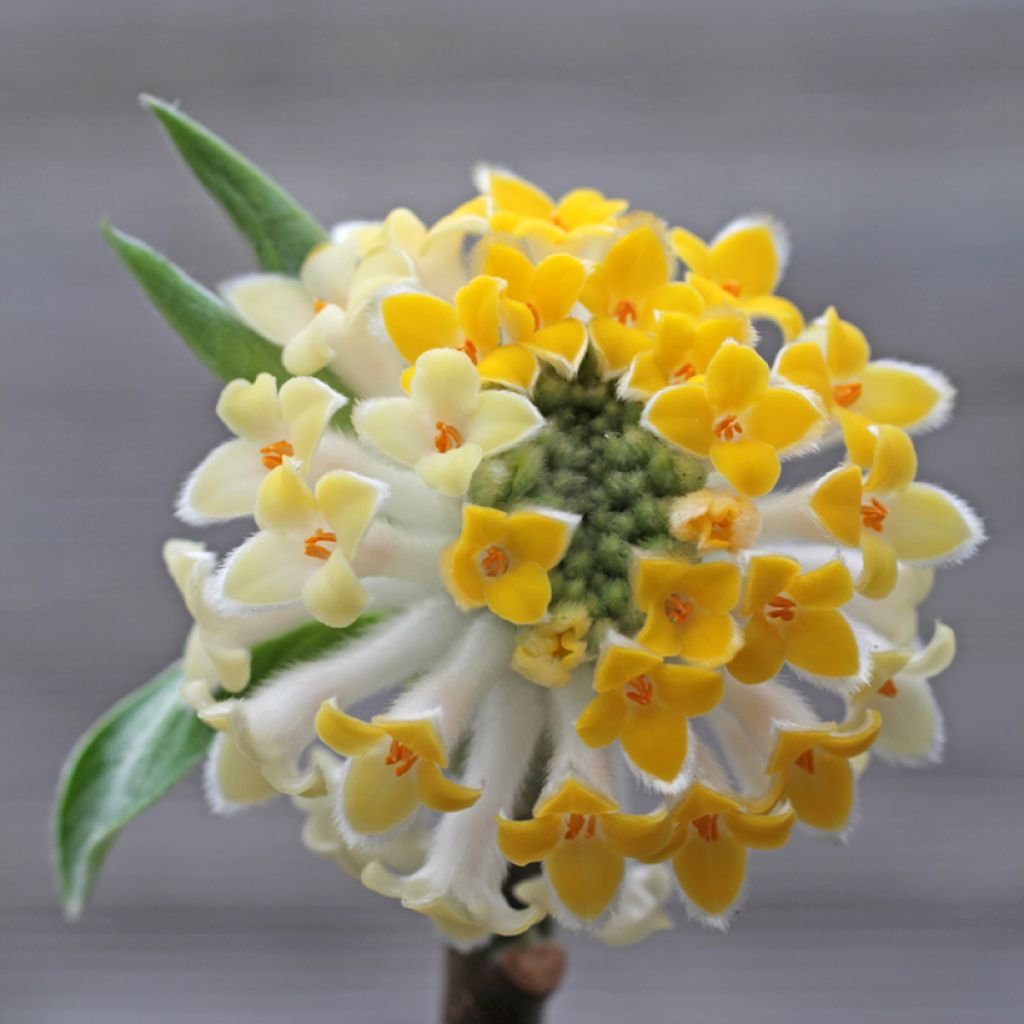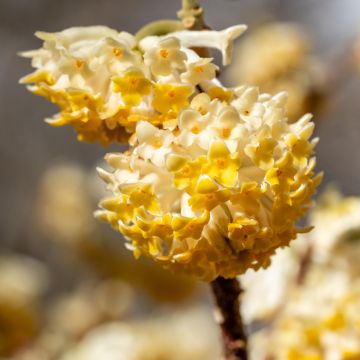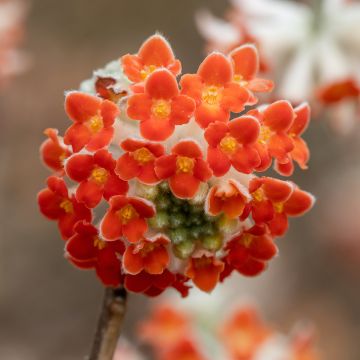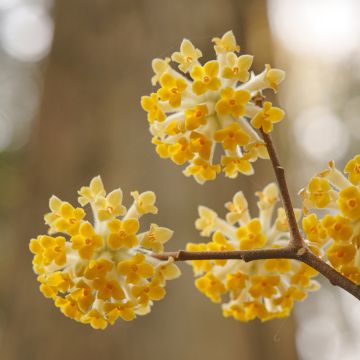

Edgeworthia chrysantha Winter Liebe - Paperbush
Edgeworthia chrysantha Winter Liebe - Paperbush
Edgeworthia chrysantha Winter Liebe
Paperbush, Oriental Paperbush, Yellow Daphne
Special offer!
Receive a €20 voucher for any order over €90 (excluding delivery costs, credit notes, and plastic-free options)!
1- Add your favorite plants to your cart.
2- Once you have reached €90, confirm your order (you can even choose the delivery date!).
3- As soon as your order is shipped, you will receive an email containing your voucher code, valid for 3 months (90 days).
Your voucher is unique and can only be used once, for any order with a minimum value of €20, excluding delivery costs.
Can be combined with other current offers, non-divisible and non-refundable.
Why not try an alternative variety in stock?
View all →This plant carries a 24 months recovery warranty
More information
We guarantee the quality of our plants for a full growing cycle, and will replace at our expense any plant that fails to recover under normal climatic and planting conditions.
Would this plant suit my garden?
Set up your Plantfit profile →
Description
Edgeworthia chrysantha 'Winter Liebe' is an improvement of the species that stands out for its larger winter flowers, a very bright, vivid yellow, with a delicious lemony scent. It forms a deciduous bush, well-branched and forming a dome not exceeding 1.5 m (4 ft 11 in) in all directions, with a regular, spread-out framework, dressed in beautiful smooth, slightly shiny, light brown to copper brown bark. The ends of its bare branches bear long tubular flowers in late winter, silky, cream white on the reverse with a bright yellow heart. Slow-growing and moderately hardy, it thrives in temperate climates with bright but not scorching exposures and in soils without limestone, light, humus-rich, moist and above all well-drained. Plant it in isolation in a sheltered corner, close to the house or in a bed in association with liriopes, hellebores, heathers, and narcissus at its feet.
Edgeworthia chrysantha (synonym E. tomentosa) is a close relative of Daphnes, belonging to the Thymelaeaceae family. It is the only species known for its ornamental qualities and its use in the production of luxury paper. This shrub is native to central China, where it is found in forests, on riverbanks, or on brushy slopes, at an altitude between 300 and 1600 m (984 ft 4 in and 5249 ft 4 in). This plant has naturalized in Japan and on the southern coast of Korea due to intensive cultivation. The plant's lifespan is about 30 to 60 years.
The 'Winter Liebe' cultivar is a recent creation, still not widely available commercially. This slow-growing bush with an elegant, spreading habit reaches about 1.50 m (4 ft 11 in) in all directions. Its very short trunk disappears as peripheral branches emerge. The thick, flexible, reddish-brown branches branch out very regularly and in a characteristic manner into three secondary branches. Flowering takes place from February to April, for about a month, at the ends of bare branches. The flower buds, protected by pretty silvery bracts, are carried by a curved peduncle that straightens up when it the buds unfurl into round, pale green umbels that bloom from the centre to the periphery. The 30 to 50 small flowers measure over 5 mm (0.2 in). Each one is composed of a silky white tube that widens into 4 lobes of a very vibrant yellow so that the inflorescence appears bicolour and brings a lot of light to the winter scenes. These nectar-rich, lemon-scented flowers emit a heady scent in calm weather, attracting bumblebees or early bees. The flowering is followed by the formation of non-edible fruits with a stone.
The exotic, deciduous foliage, fuller and larger than the species, appears after flowering, towards the ends of the branches. It consists of large alternate, lanceolate leaves, reaching up to 20 cm (7.9 in) in length, strongly veined and shiny, green-blue on the upper side, lighter and silky on the reverse. In hot weather, the leaves tend to wilt and fall prematurely.
Edgeworthia 'Winter Liebe' is a collector's shrub, to be planted near a passage or entrance to enjoy its fragrance. It is not more widely planted in our gardens due to its relatively low hardiness, around -12°C in a sheltered position, the sensitivity of its flowering to dry and icy winds, and its aversion to heat. Like rhododendrons, it does not tolerate the presence of limestone and requires soil that remains moist but well-drained. Therefore, it will naturally find a place alongside other acid-loving shrubs such as Camellias, Pieris, Kalmia, and tree heathers.
Also known as Mistumata or paper tree, Edgeworthia chrysantha is used in Japan to make high-quality paper from its branches: washi. The resulting pulp gives the paper a unique texture and makes it resistant to the effects of time, humidity, and insects.
Report an error about the product description
Plant habit
Flowering
Foliage
Botanical data
Edgeworthia
chrysantha
Winter Liebe
Thymeleaceae
Paperbush, Oriental Paperbush, Yellow Daphne
Cultivar or hybrid
Planting and care
Edgeworthia chrysantha can be exposed to full sun or, at most, partial shade. It can tolerate all types of non-chalky soil but prefers it light, moist, fertile, and well-drained. A humus-rich and deep soil is ideal. Remember to water it regularly, with non-chalky water. It can withstand temperatures from -10 to -15°C (14 to 5 °F) and thrives in mild and humid coastal climates, just like rhododendrons, azaleas, and camellias. This bush does not require pruning.
Planting period
Intended location
Care
This item has not been reviewed yet - be the first to leave a review about it.
Haven't found what you were looking for?
Hardiness is the lowest winter temperature a plant can endure without suffering serious damage or even dying. However, hardiness is affected by location (a sheltered area, such as a patio), protection (winter cover) and soil type (hardiness is improved by well-drained soil).

Photo Sharing Terms & Conditions
In order to encourage gardeners to interact and share their experiences, Promesse de fleurs offers various media enabling content to be uploaded onto its Site - in particular via the ‘Photo sharing’ module.
The User agrees to refrain from:
- Posting any content that is illegal, prejudicial, insulting, racist, inciteful to hatred, revisionist, contrary to public decency, that infringes on privacy or on the privacy rights of third parties, in particular the publicity rights of persons and goods, intellectual property rights, or the right to privacy.
- Submitting content on behalf of a third party;
- Impersonate the identity of a third party and/or publish any personal information about a third party;
In general, the User undertakes to refrain from any unethical behaviour.
All Content (in particular text, comments, files, images, photos, videos, creative works, etc.), which may be subject to property or intellectual property rights, image or other private rights, shall remain the property of the User, subject to the limited rights granted by the terms of the licence granted by Promesse de fleurs as stated below. Users are at liberty to publish or not to publish such Content on the Site, notably via the ‘Photo Sharing’ facility, and accept that this Content shall be made public and freely accessible, notably on the Internet.
Users further acknowledge, undertake to have ,and guarantee that they hold all necessary rights and permissions to publish such material on the Site, in particular with regard to the legislation in force pertaining to any privacy, property, intellectual property, image, or contractual rights, or rights of any other nature. By publishing such Content on the Site, Users acknowledge accepting full liability as publishers of the Content within the meaning of the law, and grant Promesse de fleurs, free of charge, an inclusive, worldwide licence for the said Content for the entire duration of its publication, including all reproduction, representation, up/downloading, displaying, performing, transmission, and storage rights.
Users also grant permission for their name to be linked to the Content and accept that this link may not always be made available.
By engaging in posting material, Users consent to their Content becoming automatically accessible on the Internet, in particular on other sites and/or blogs and/or web pages of the Promesse de fleurs site, including in particular social pages and the Promesse de fleurs catalogue.
Users may secure the removal of entrusted content free of charge by issuing a simple request via our contact form.
The flowering period indicated on our website applies to countries and regions located in USDA zone 8 (France, the United Kingdom, Ireland, the Netherlands, etc.)
It will vary according to where you live:
- In zones 9 to 10 (Italy, Spain, Greece, etc.), flowering will occur about 2 to 4 weeks earlier.
- In zones 6 to 7 (Germany, Poland, Slovenia, and lower mountainous regions), flowering will be delayed by 2 to 3 weeks.
- In zone 5 (Central Europe, Scandinavia), blooming will be delayed by 3 to 5 weeks.
In temperate climates, pruning of spring-flowering shrubs (forsythia, spireas, etc.) should be done just after flowering.
Pruning of summer-flowering shrubs (Indian Lilac, Perovskia, etc.) can be done in winter or spring.
In cold regions as well as with frost-sensitive plants, avoid pruning too early when severe frosts may still occur.
The planting period indicated on our website applies to countries and regions located in USDA zone 8 (France, United Kingdom, Ireland, Netherlands).
It will vary according to where you live:
- In Mediterranean zones (Marseille, Madrid, Milan, etc.), autumn and winter are the best planting periods.
- In continental zones (Strasbourg, Munich, Vienna, etc.), delay planting by 2 to 3 weeks in spring and bring it forward by 2 to 4 weeks in autumn.
- In mountainous regions (the Alps, Pyrenees, Carpathians, etc.), it is best to plant in late spring (May-June) or late summer (August-September).
The harvesting period indicated on our website applies to countries and regions in USDA zone 8 (France, England, Ireland, the Netherlands).
In colder areas (Scandinavia, Poland, Austria...) fruit and vegetable harvests are likely to be delayed by 3-4 weeks.
In warmer areas (Italy, Spain, Greece, etc.), harvesting will probably take place earlier, depending on weather conditions.
The sowing periods indicated on our website apply to countries and regions within USDA Zone 8 (France, UK, Ireland, Netherlands).
In colder areas (Scandinavia, Poland, Austria...), delay any outdoor sowing by 3-4 weeks, or sow under glass.
In warmer climes (Italy, Spain, Greece, etc.), bring outdoor sowing forward by a few weeks.




































